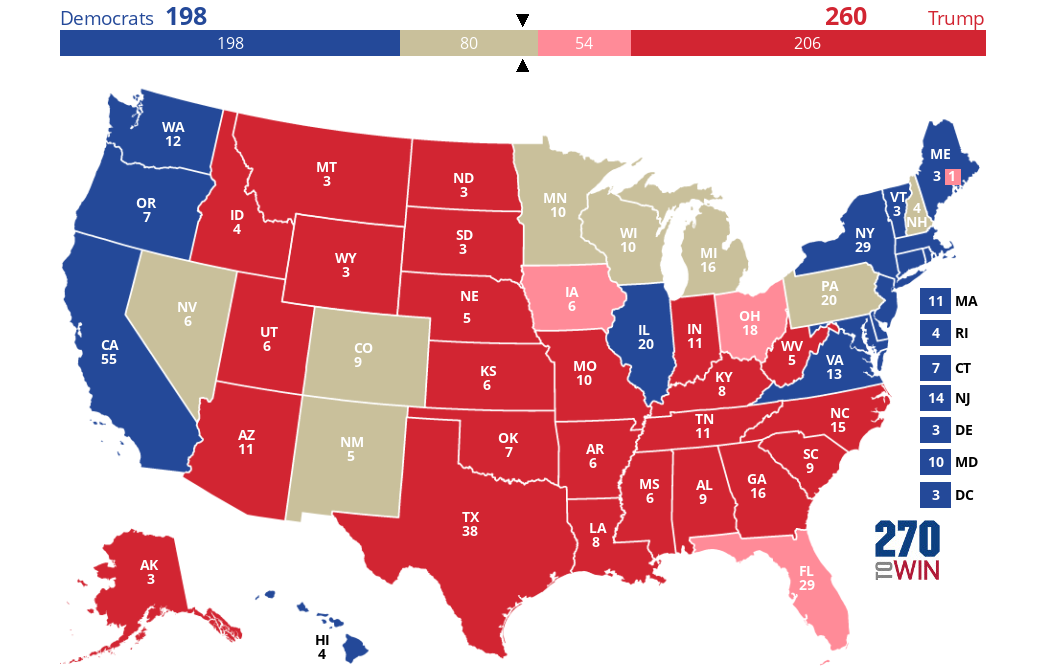Trump Campaign Looks to Expand Electoral Map in 2020
By 270toWin Staff
April 29, 2019
The Trump reelection effort will look to expand the electoral map in 2020, campaign manager Brad Parscale said on CBS Face the Nation Sunday.
===
From the transcript, with bold and 2016 margin added:
(Moderator) MARGARET BRENNAN: Where? Where are you most focused? What battlegrounds?
PARSCALE: Well, there's some key states. Obviously we have to go back and win Michigan (0.2%) again, Pennsylvania (0.7%), Wisconsin (0.8%). We plan on also being in Minnesota (1.5%) very soon. I think New Mexico (8.2%) is in play in 2020. I think New Hampshire (0.4%), I- I think we continue to grow the map. I think Nevada (2.4%), you know even Colorado (4.9%). And so those are- those are states we did not win in- in 2016 that I think are open for 2020.
===
Trump won Michigan, Pennsylvania and Wisconsin in 2016, each by less than 1%. These are states that had not voted Republican in any presidential election in more than a generation. Clinton won by single digits in the five other states Parscale referenced.
In the map below (click/tap for an interactive version), we show the 8 states mentioned as toss-up. The other locations Trump flipped in 2016 are shown in a lighter shade of red. Use it as a starting point to create your own 2020 forecast. Also note the Road to 270 feature below the interactive map, which will update the winning combinations available to each party based on your map.
New Hampshire: Traditionally thought of as a battleground, it has not voted Republican since 2000. However, Trump won three counties here and all ten of the state's counties shifted toward the GOP from 2012 to 2016.
Minnesota: No state has a longer streak of voting Democratic. The only state won by Mondale in 1984, it last voted for a Republican nominee - Richard Nixon - in 1972. Clinton's narrow win was by the smallest margin since that 1984 election. It has generally not been considered a battleground state, although the majority of elections since 1972 have been decided by fewer than 10 points. Trump won all but 9 of the state's 87 counties, although not by enough to overcome Clinton's performance in the more populous parts of the state.
Nevada: 2016 was only the 2nd time since 1908 (1976 being the other) that the state did not vote for the winner of the presidential election, although the 2.4% Clinton margin was very close to her 2.1% popular vote margin nationwide. Clinton won Clark County (Las Vegas area) by about 6%, while Trump won the remainder of the state by over 15%. Rapidly growing and increasingly diverse, Las Vegas is where most of the population is. It is an open question if 2016 was a historical outlier or if these trends have put the state out of reach for the GOP in a close election.
Colorado: Predominantly Republican prior to 2008, Clinton's 5 point margin here in 2016 was within one point of Obama's in 2012. Trump was the first Republican to win the presidency without winning Colorado since Taft in 1908. Some of the same population factors impacting Nevada are at work here as well.
New Mexico: Having voted Democratic in six of the past seven elections, and with the country's largest Hispanic population, this seems like the biggest reach of the states listed. That said, Libertarian Party nominee Gary Johnson, the state's former governor, received over 9% of the vote here, his best showing in any state. That was greater than Clinton's winning margin, so perhaps the thinking is that many of those voters are reachable for the president in 2020.
Parscale did not mention Maine, where Trump's double-digit margin in the 2nd congressional district (earning him an electoral vote) helped him hold Clinton's statewide margin to under 3%. This was the most narrow victory by any Democrat in the seven consecutive presidential elections they have won here.
Finally, while noting the need to win again in states like Michigan, Pennsylvania and Wisconsin, no mention was made of holding other competitive states Trump won in 2016. For example, Arizona, North Carolina and Georgia were all closer than New Mexico and demographic trends in these states will likely make them 2020 battlegrounds. Looking back, some of the (admittedly after-the-fact) criticism of the Clinton campaign was its focus on growing the map vs. shoring up the states that would have put them over the required 270 electoral votes.


